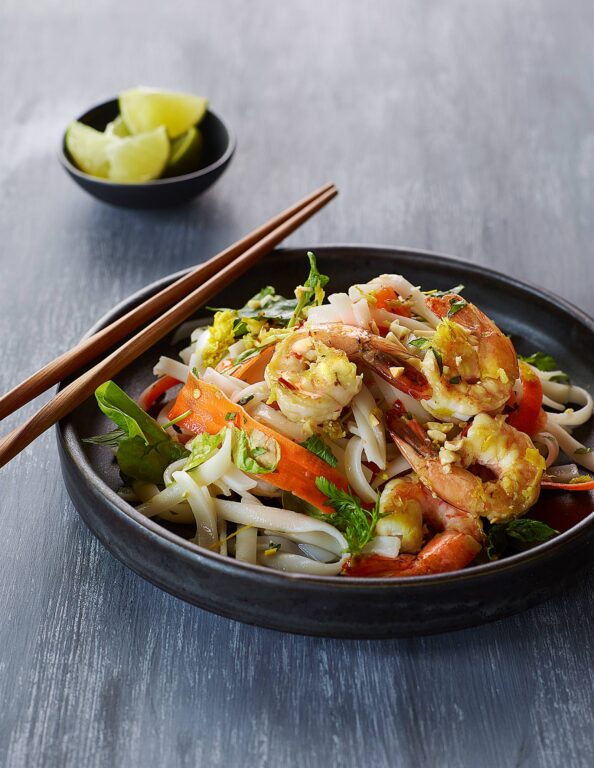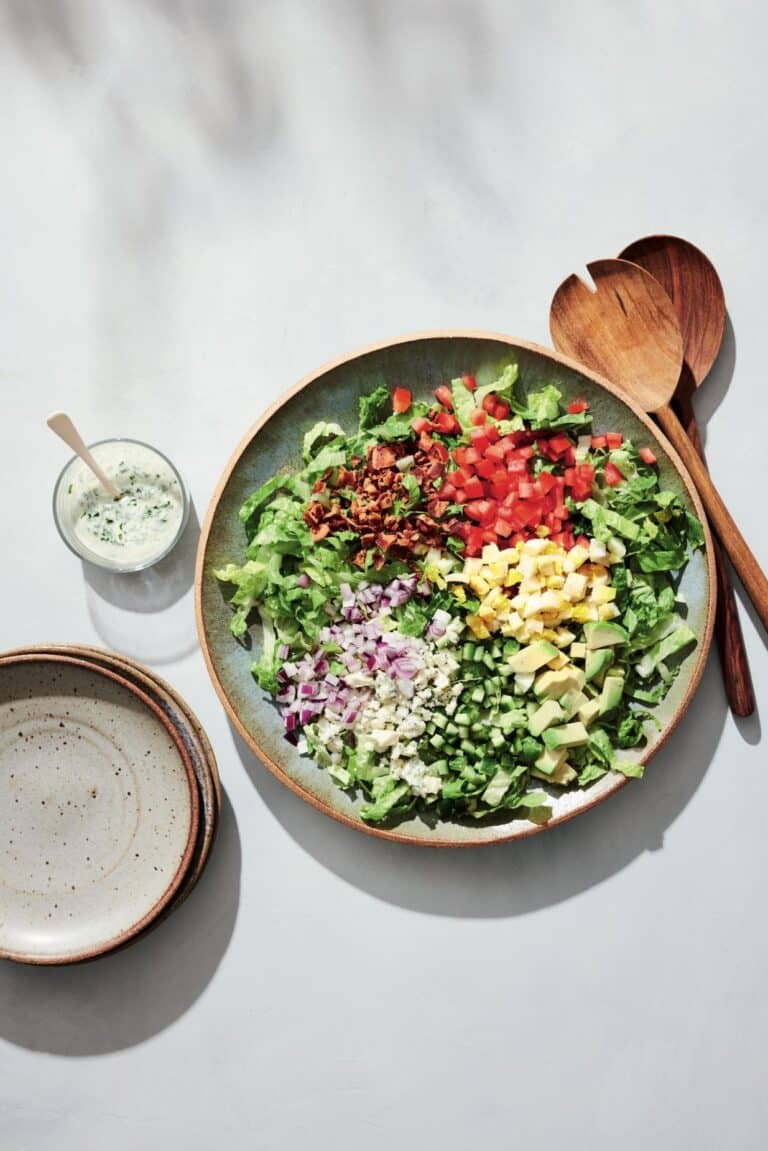
Think of this fresh and crunchy salad as a cross between shrimp pad Thai and a spicy noodle salad. Although I love traditional pad Thai, with its stir-fried noodles and tangy tamarind sauce, at home I am more likely to go light on the noodles and heavy on the vegetables. This dish is especially good with Forbidden Rice noodles, a purple-black variety made from anthocyanin- rich Forbidden Rice (aka black). If you can’t find it, use regular rice or brown rice noodles instead.
There’s really no substitute for the intense, citronella-like aroma and flavor that fresh lemongrass adds to the shrimp. In a pinch, you can get by using lemongrass paste in a tube (use 2 tablespoons paste for 3 tablespoons freshly chopped). The good news is, most grocery stores now carry fresh lemongrass stalks. Look for them in the produce section next to the ginger.
INGREDIENTS:
- ¼ cup (60 ml) fresh lime juice
- ¼ cup (60 ml) rice vinegar
- 1½ to 2 teaspoons sambal oelek (Indonesian fresh chili paste)
- ½ pound (225 g) Forbidden Rice noodles (or thin, pad Thai–style rice noodles)
- 1 tablespoon avocado oil
- 1 large shallot (5 ounces/ 140 g), finely chopped (about ½ cup)
- 3 tablespoons finely chopped lemongrass, pale, tender centers only
- One 1-inch (2.5 cm) piece fresh ginger, grated (about 1 tablespoon)
- 3 large garlic cloves, chopped (about
- 1 tablespoon)
- 1 pound (455 g) medium shrimp (about 30), peeled and deveined (see Tip)
- 3 medium carrots (12 ounces/340 g), shaved into ribbons with a vegetable peeler
- 2 loosely packed cups (80 g) tender lettuces (butter, Bibb, or baby romaine), torn into bite-size pieces
- 2 cups (60 g) chopped fresh mixed herbs (mint, basil, and cilantro leaves), plus more for garnish
- ½ cup (70 g) raw peanuts, roughly chopped
- Lime wedges
DIRECTIONS:
- Stir together the lime juice, vinegar, and 1½ teaspoons of the sambal oelek (more if you prefer a spicier dish) in a large bowl. Set aside, reserving 2 tablespoons of the dressing to drizzle on the finished dish.
- Bring a large pot of water to a boil. Add the noodles and cook, stirring occasionally until tender, 5 to 6 minutes. (Or follow the package directions, as some rice noodles will cook by soaking in hot water.) Drain well, add to the bowl with the dressing, toss, and set aside.
- Heat the oil in a large nonstick skillet over medium heat. Add the shallot, lemongrass, and ginger and cook until the shallot is translucent, 5 to 7 minutes. Add the garlic and the shrimp, stir to coat with the lemongrass mixture, and cook until the shrimp are just pink on both sides, about 4 minutes total. Turn off the heat and set aside.
- Add the carrots, lettuce, and herbs to the bowl of noodles. Toss well and divide among shallow bowls. Top with the shrimp, then sprinkle with the peanuts and more herbs. Just before serving, drizzle with the reserved dressing. Serve warm, at room temperature, or chilled, with lime wedges alongside.
TIP: When purchasing shrimp, look for American wild-caught shrimp. Shrimp imported from other countries is more likely to be contaminated with environmental toxins, fraudulently labeled, and the result of unethical labor practices. If purchasing frozen shrimp at the grocery store, look for peeled, tail-on shrimp for the best product. Cleaning the shrimp of its innards takes only a minute and ensures your shrimp will be safe to eat. Just take a sharp knife along the back and under the belly and remove any dark-colored debris. Or ask the fishmonger at the grocery store to clean them for you. As for canned shrimp: don’t buy it. Most is imported from countries with questionable farming practices and heavy use of antibiotics.
SCIENCE BITE: ASTAXANTHIN IN SHRIMP
Shrimp is rich in the antioxidant astaxanthin, a member of the carotenoid family of nutrients. Animal studies have documented that astaxanthin exerts impressive neuroprotective effects on cognition and memory. Its antioxidant power is active right where the brain is most vulnerable to amyloid deposition—in the hippocampus. Scientists hope to prove that getting enough astaxanthin in the diet has the same neuroprotective properties in human brains, and it is being evaluated as a possible therapeutic agent for Alzheimer’s and Parkinson’s diseases. Besides shrimp, crab and scallops are also rich in astaxanthin.
Recipe and photo reprinted with permission from The Brain Health Kitchen Cookbook by Annie Fenn photo by Alexandra Grablewski Artisan/2023




